Unfortunately, he only met Dalí's works. But what better way to celebrate a wedding anniversary than to visit the Dalí's exhibition? -sheepish grin- First, you gotta have a wonderful wife like mine, who enjoys accompanying me to museums.
This year, we visited the three exhibitions are the Marina Bay Sands Art Science Museum: Dalí Mind of A Genius, Shipwrecked Tang Treasures and Monsoon Winds, and Van Gogh Alive. My dear wife, all dressed up for the big occasion of our anniversary, walked with me for a three hours in heels. Ouchie! Thank you dear!
I had always wanted to visit a Dalí exhibition after coming across the Dalí Universe exhibition at London County Hall in 2008 (yes, its the same trip with the Terracotta Warriors at the British Museum).
So this post is mainly about the Dalí exhibition. Photos are taken using my Galaxy S2, not exactly perfect quality. Descriptions are mostly from the exhibition itself.
The exhibition featured 10 galleries of Salvador Dalí's 250 pieces of artwork.
 "What is important is to spread confusion, not to eliminate it."
"What is important is to spread confusion, not to eliminate it."
 The Dance of Time II (conceived in 1979, first cast in 1984, bronze) greeted us at the entrance to the mind of the genius... It is the trademark soft watch in his famous oil painting, The Persistence of Memory.
The Dance of Time II (conceived in 1979, first cast in 1984, bronze) greeted us at the entrance to the mind of the genius... It is the trademark soft watch in his famous oil painting, The Persistence of Memory.
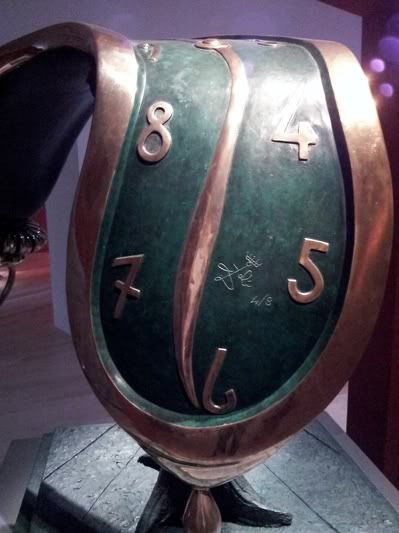
The Woman Aflame.

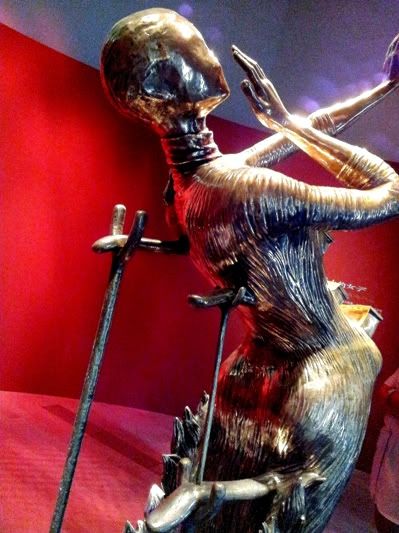
This sculpture unites two of Dalí's obsessions: fire and a female figure with drawers. The flames seem to have a life of their own and represent the concealed intensity of unconscious desire, while the drawers represent the unknown of hidden secrets. This intriguing, faceless female symbolized all women as though a woman's beauty laid in her mystery.
The crutch is another symbol frequently used in Dalí's work. He also calls it the 'symbol of death' and the 'symbol of resurrection'. It represents a blend of authority, stability and sexual power.
Interestingly, Dalí used many symbols in his works. The following are some of their meanings:
Drawers - Secrets
Ant: Death and Sexual Desire
Crutch: Death and Resurrection
Grasshopper: Fear and Anxiety
Butterflies: Soul
Look out for these symbols in the rest of this post.
Space Venus (conceived in 1977, first cast in 1984, bronze).
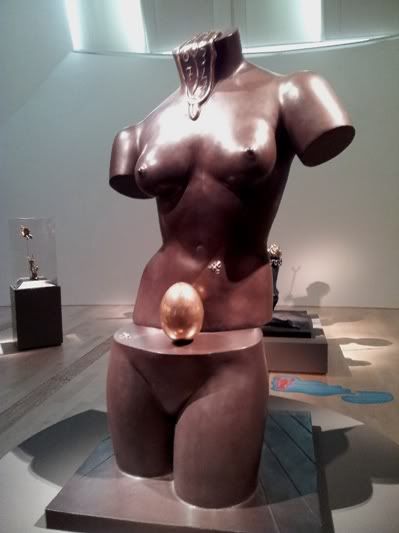
Venus, in Greco-Roman mythology is the goddess of beauty. This sculpture represents a classic, marble female torso, and adds four Dalínian elements: a soft clock, an egg, ants and a separation of body into two parts. The clock is draped over the neck to give us two opposing messages: that beauty of flesh is temporary and will vanish, while beauty of art is timeless and eternal. The ants are reminders of human mortality and impermanence, while in the centre, the egg is a positive symbol of life, renewal, continuation and future. Dalí often referred to dual themes or elements such as hard and soft, eternal and temporary, dream and reality.
Yin and Yang (1968, bronze).
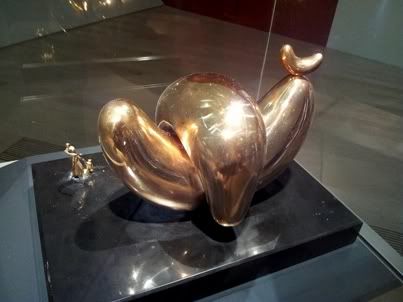
In Chinese dualistic philosophy, Yang represents the active, masculine and cosmic principle, symbolized by the sun. Yin signifies the passive, female force. Yin does not only symbolize 'moon', but also 'shade' and 'femininity'.
Woman of Time (conceived in 1973, first cast in 1984, bronze).
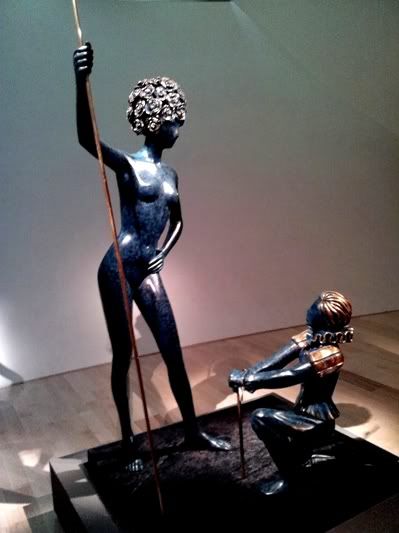

Holding a flower and dressed in gently flowing robes, this radiant young woman bears Dalí's most famous symbol. The clock poses the question - is beauty dependent on time, or is it eternal?
The Anthropomorphic Cabinet.
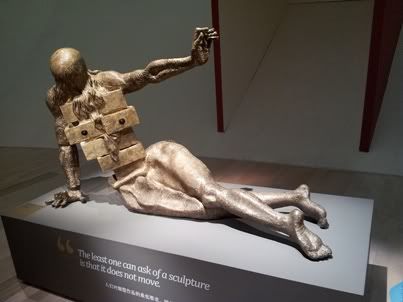
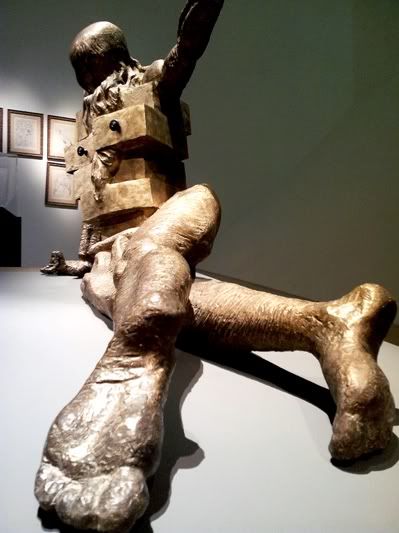
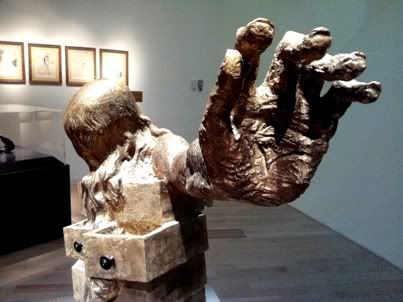 Over he years Dalí has made a number of drawings of the Anthropomorphic Cabinet with slight variations. Significantly, in all version, including the sculpture, the face is concealed by long hair. The sculpture is titled anthropomorphic, meaning 'in the form of a human'. The draws are empty, apparently suggesting that the cabinet may be a place where we can store images that rise from our subconscious. Like in Woman Aflame, drawers symbolize hidden secrets.
Over he years Dalí has made a number of drawings of the Anthropomorphic Cabinet with slight variations. Significantly, in all version, including the sculpture, the face is concealed by long hair. The sculpture is titled anthropomorphic, meaning 'in the form of a human'. The draws are empty, apparently suggesting that the cabinet may be a place where we can store images that rise from our subconscious. Like in Woman Aflame, drawers symbolize hidden secrets.
Adam and Eve (conceived in 1968, first cast in 1984, bronze).
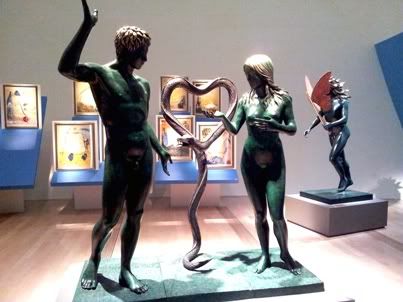
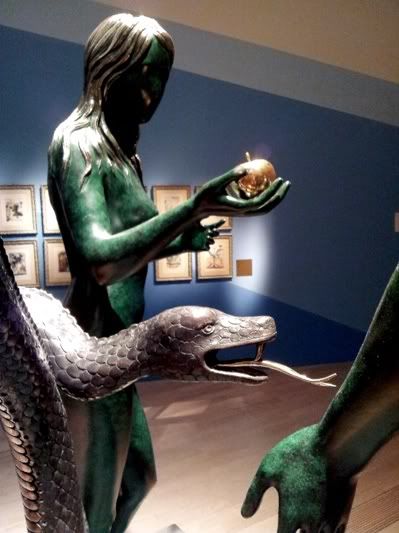
Man with Butterfly (conceived in 1968, cast in 1984, bronze).
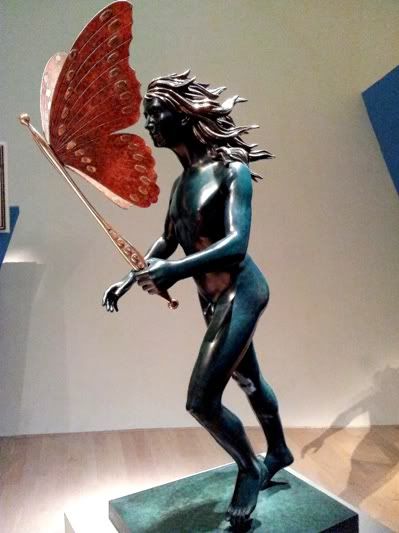
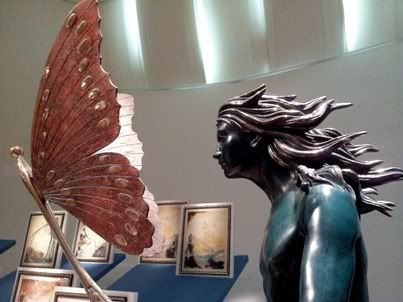
Lady Godiva with Butterflies (conceived in 1976, first cast in 1984, bronze).
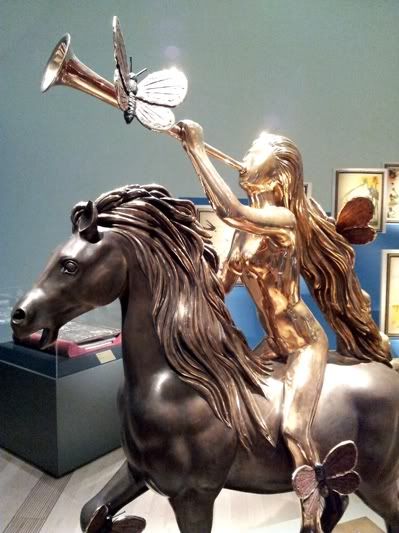
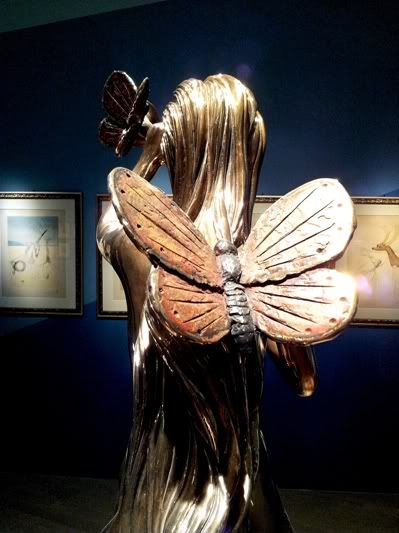
Lady Godiva (1040-1080) was an Anglo-Saxon noble woman who took pity on the people of her city who suffered her husband's abusive taxation. According to the legend, she rode naked through the streets to gain a remission from the oppressive taxation. Dalí pays homage to her sensuous forms as she embodies earthly beauty, whereas the butterflies depict an ethereal world.
Unicorn (conceived in 1997, first cast in 1984, bronze).
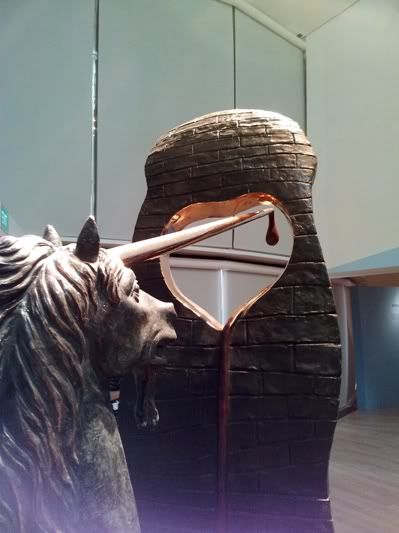
The unicorn is a mystical creature prominent in legends and a symbol of purity and virginity. Its horn is believed to be capable of neutralizing any poison. Dalí chose to portray the unicorn as a phallic figure whose horn penetrates a stone wall through a heart-shaped opening, from which a drop of blood seems to be slowly falling.
St. George and the Dragon (conceived in 1977, first cast in 1984, bronze).
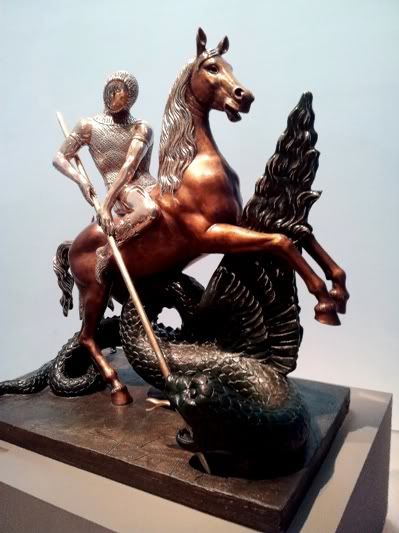
The classic interpretation of St. George and the Dragon is comonly seen as the saint's battle against heresy and evil. The dragon's wings turn into flames, and the monster's tongue into a crutch, a favourite Dalínian image. We see a woman with her arm raised in the sign of victory. Dalí again transforms a traditional image by adding new and unexpected symbolic connotations.
Homage to Terpsichore (conceived in 1977, first cast in 1984, bronze).
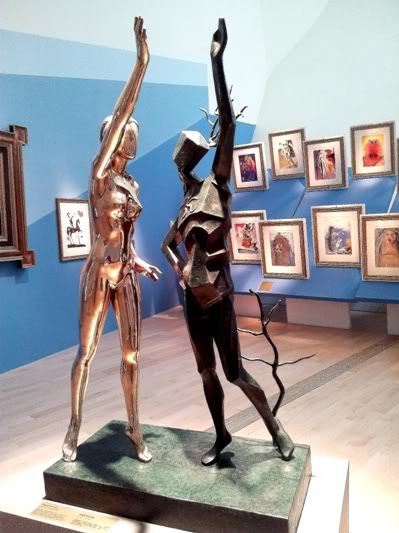
Terpsichore, in Greek mythology, is one of the nine muses ruling over dance and the dramatic chorus. Dalí used a reflected image, setting the soft, carnal muse against the hardened, statuesque one. The lack of definition in both faces underlines the purely symbolic significance of these figures.
The Bible.
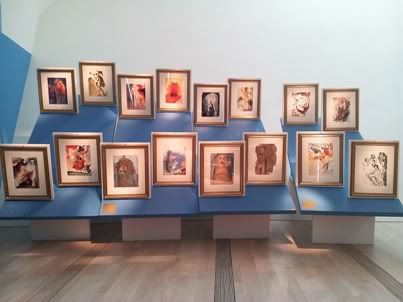
It is one of Dalí undisputed masterpieces. The myriad of tales of humanity, with all its virtues and vices, are depicted by Dalí with vigour and versatility, using bold lines and vibrant colours. Despite the fact that Dalí's father was an atheist, Dalí felt the influence of this mother who was a devout Catholic. After attempts at renouncing Catholicism, Dalí proclaimed his faith in the Church.
Snail and the Angel.
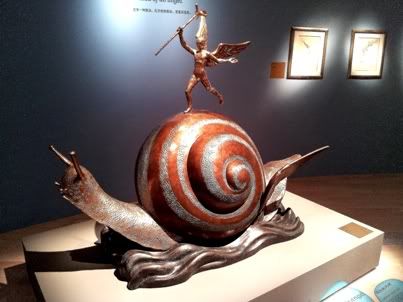
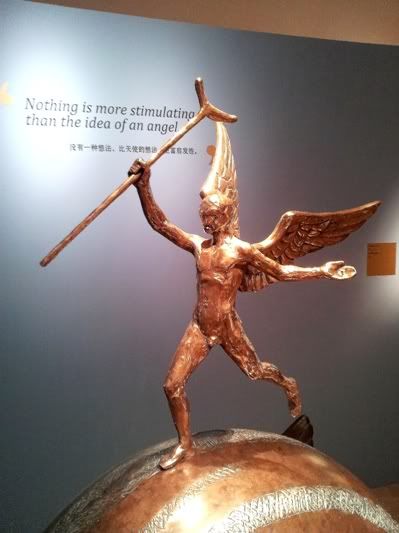
Dalí brings together the angel and a giant snail. By creating this fantastic sculpture, he transports us into another universe where reality and dreams are inseparable. The snail, which is very slow in its movements, has been given wings and is now fluidly moving.
Triumphant Angel (conceived in 1976, first cast in 1984, bronze).
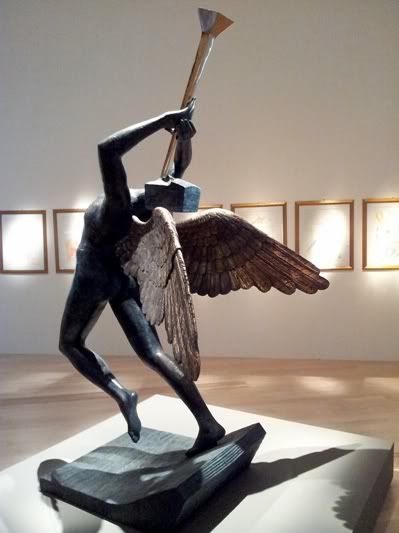
Vision of the Angel (conceived in 1977, first cast in 1984, bronze).
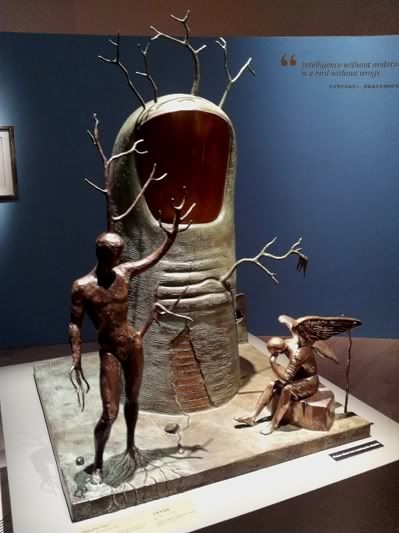
The strength and supremacy of God is here represented by a thumb from which life emerges, symbolized by the tree branches.
Surrealist Warrior (conceived in 1971, first cast in 1984, bronze).
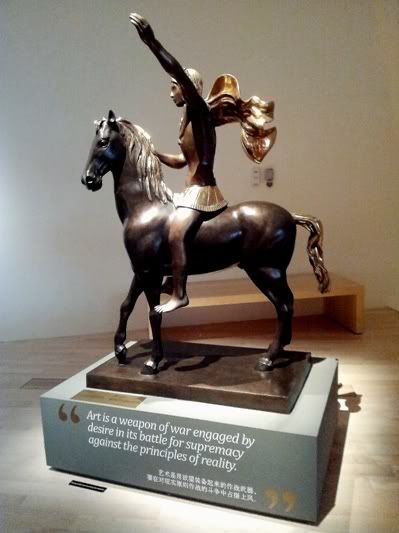
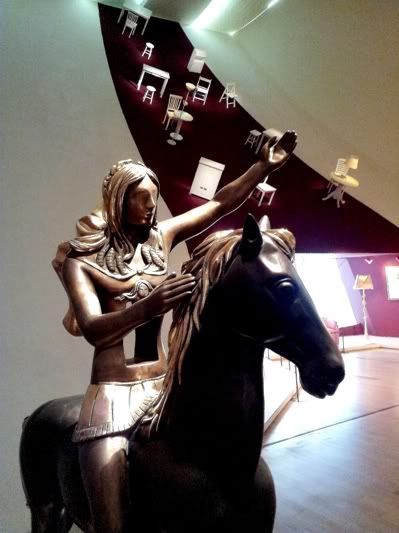
The image of this Roman warrior represents all victories, real and ethereal, spiritual and physical. Dalí surrealistic interpretation of the warrior includes the addition of a window of light, portrayed through a 'hole' in the warrior's chest.
Besides bronze sculptures and drawings, the exhibition also featured Dalí's works in Daum glass. At the end of the 1960s, the artistic collaboration between Dalí and the prestigious glass making company, Crystal Daum, gave birth to one of the most interesting collections of colour-glass sculpture. Glass offered the perfect medium for the expression of metamorphoses which was ideal for the surrealistic perception of reality. Glass easily allowed for melted forms and transformation of light and colour. Many pieces were inspired by abandoned objects and debris washed up by the sea. Others, instead, derived from his fascination with liquid, rubbery and soft materials.
Melted Clock (1988, created for Crystal Daum, glass paste, cobalt blue and gold).
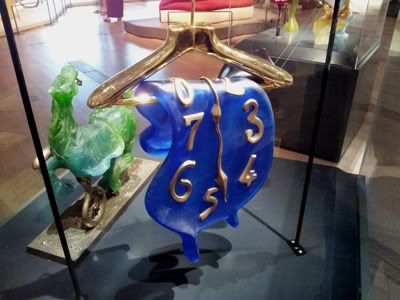
In 1865, Lewis Carroll published his famous novel Alice in Wonderland. In this fairytale, Alice goes through a series of incredible adventures, meets odd characters, encounters dangers, and has to adapt to all these astonishing situations. She represents the eternal child who responds to the confusion of the world with the naivety of her childhood. After her meetings with the inhabitants of this fantastic world, Alice returns to reality unharmed and unchanged by her surrealistic experience. Like Alice, Dalí travelled a long and arduous road through the land of dreams. Dalí was drawn to both the incredible story and the extravagant characters in this fairytale. Alice is one of Dalí's favourite images and is an ideal representation of Surrealism.
Alice in Wonderland (conceived in 1977, first cast in 1984, bronze).
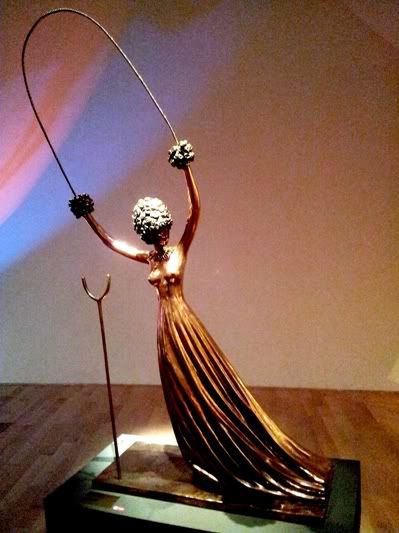
Space Elephant (conceived and first cast in 1980, bronze).
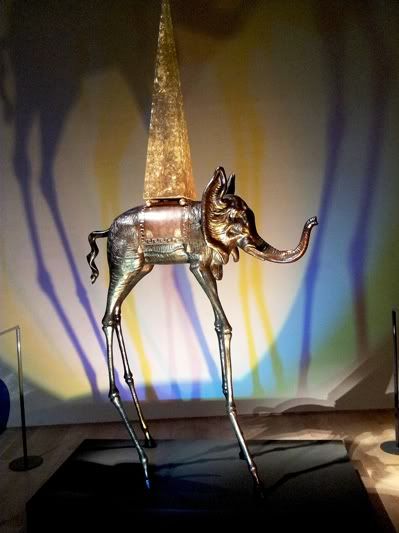
Dalí created the image of an elephant carrying an obelisk, a symbol of technological progress in the modern world. The almost invisible spindle-like legs emphasizes the contrast between robustness and fragility, weight and lightness. This phantasmagoria creature seems to be coming out from a dream.
Persistence of Memory (conceived and first cast in 1980, bronze).

This sculpture is named after Dalí's famous painting Persistence of Memory (1931) now in the Museum of Modern Art, New York. It is a simple figure, a limp clock draped over the branch of a dead tree. The unexpected softness of the clock represents the time, while precise in scientific use, is widely variable in human perception.

Horse Saddled with Time (conceived and first cast in 1980, bronze).
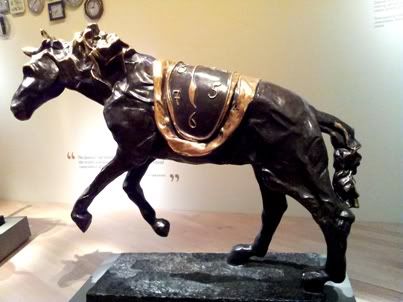
The horse is saddled with Dalínian time: time which controls man's passage. The famous melted clock is used in place of a normal saddle. While man believes he is in control of the voyage, it is always 'time' who is the ultimate rider.
We indulged ourselves in the Dalínian surrealistic world with these funny mirrors.
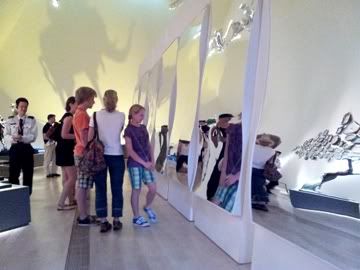
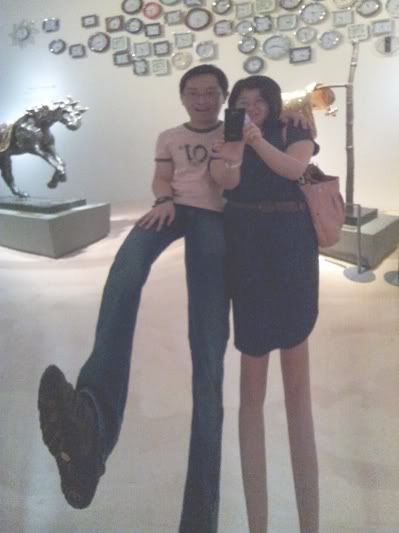
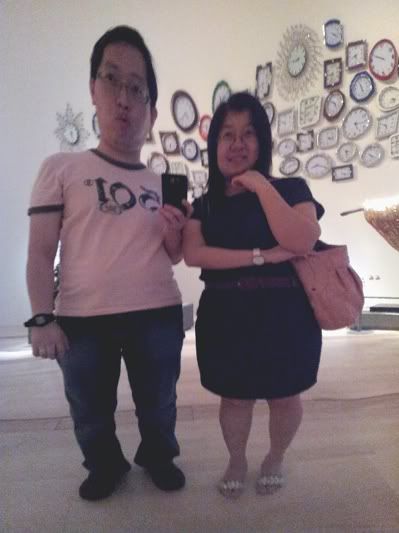
Spellbound.
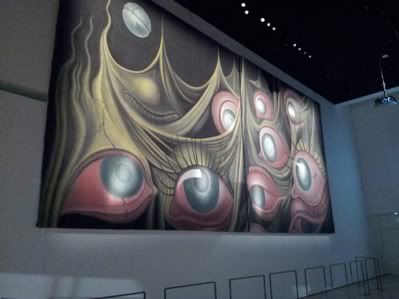
This spectacular painting is a result of unique collaboration between Alfred Hitchcock and Dalí. Hitchcock's Oscar-winning movie Spellbound (1945) starred two of Hollywood's biggest names, Ingrid Bergman and Gregory Peck, and was one of the very first films to present Freudian psychoanalysis. Alfred Hitchcock commissioned Dalí to create a film sequence which is now an integral part of Hollywood history. Spellbound was used as the background to the filming of the dream sequence. Dalí vividly captured the illusory nature of the subconscious state where reality is blurred and the mind is animated with suppressed thoughts and hidden codes.
While this exhibition had been an eye opener for us, the most enjoyable part of the celebration had got to be the dinner. We did not dine at some posh restaurant. We had a simple meal at Kenny Rogers' @ Marina Square. Incidentally, our first date was at Marina Square's Kenny Rogers (the old one)!
Happy Anniversary!
This year, we visited the three exhibitions are the Marina Bay Sands Art Science Museum: Dalí Mind of A Genius, Shipwrecked Tang Treasures and Monsoon Winds, and Van Gogh Alive. My dear wife, all dressed up for the big occasion of our anniversary, walked with me for a three hours in heels. Ouchie! Thank you dear!
I had always wanted to visit a Dalí exhibition after coming across the Dalí Universe exhibition at London County Hall in 2008 (yes, its the same trip with the Terracotta Warriors at the British Museum).
So this post is mainly about the Dalí exhibition. Photos are taken using my Galaxy S2, not exactly perfect quality. Descriptions are mostly from the exhibition itself.
The exhibition featured 10 galleries of Salvador Dalí's 250 pieces of artwork.



The Woman Aflame.


This sculpture unites two of Dalí's obsessions: fire and a female figure with drawers. The flames seem to have a life of their own and represent the concealed intensity of unconscious desire, while the drawers represent the unknown of hidden secrets. This intriguing, faceless female symbolized all women as though a woman's beauty laid in her mystery.
The crutch is another symbol frequently used in Dalí's work. He also calls it the 'symbol of death' and the 'symbol of resurrection'. It represents a blend of authority, stability and sexual power.
Interestingly, Dalí used many symbols in his works. The following are some of their meanings:
Drawers - Secrets
Ant: Death and Sexual Desire
Crutch: Death and Resurrection
Grasshopper: Fear and Anxiety
Butterflies: Soul
Look out for these symbols in the rest of this post.
Space Venus (conceived in 1977, first cast in 1984, bronze).

Venus, in Greco-Roman mythology is the goddess of beauty. This sculpture represents a classic, marble female torso, and adds four Dalínian elements: a soft clock, an egg, ants and a separation of body into two parts. The clock is draped over the neck to give us two opposing messages: that beauty of flesh is temporary and will vanish, while beauty of art is timeless and eternal. The ants are reminders of human mortality and impermanence, while in the centre, the egg is a positive symbol of life, renewal, continuation and future. Dalí often referred to dual themes or elements such as hard and soft, eternal and temporary, dream and reality.
Yin and Yang (1968, bronze).

In Chinese dualistic philosophy, Yang represents the active, masculine and cosmic principle, symbolized by the sun. Yin signifies the passive, female force. Yin does not only symbolize 'moon', but also 'shade' and 'femininity'.
Woman of Time (conceived in 1973, first cast in 1984, bronze).


Holding a flower and dressed in gently flowing robes, this radiant young woman bears Dalí's most famous symbol. The clock poses the question - is beauty dependent on time, or is it eternal?
The Anthropomorphic Cabinet.



Adam and Eve (conceived in 1968, first cast in 1984, bronze).


Man with Butterfly (conceived in 1968, cast in 1984, bronze).


Lady Godiva with Butterflies (conceived in 1976, first cast in 1984, bronze).


Lady Godiva (1040-1080) was an Anglo-Saxon noble woman who took pity on the people of her city who suffered her husband's abusive taxation. According to the legend, she rode naked through the streets to gain a remission from the oppressive taxation. Dalí pays homage to her sensuous forms as she embodies earthly beauty, whereas the butterflies depict an ethereal world.
Unicorn (conceived in 1997, first cast in 1984, bronze).

The unicorn is a mystical creature prominent in legends and a symbol of purity and virginity. Its horn is believed to be capable of neutralizing any poison. Dalí chose to portray the unicorn as a phallic figure whose horn penetrates a stone wall through a heart-shaped opening, from which a drop of blood seems to be slowly falling.
St. George and the Dragon (conceived in 1977, first cast in 1984, bronze).

The classic interpretation of St. George and the Dragon is comonly seen as the saint's battle against heresy and evil. The dragon's wings turn into flames, and the monster's tongue into a crutch, a favourite Dalínian image. We see a woman with her arm raised in the sign of victory. Dalí again transforms a traditional image by adding new and unexpected symbolic connotations.
Homage to Terpsichore (conceived in 1977, first cast in 1984, bronze).

Terpsichore, in Greek mythology, is one of the nine muses ruling over dance and the dramatic chorus. Dalí used a reflected image, setting the soft, carnal muse against the hardened, statuesque one. The lack of definition in both faces underlines the purely symbolic significance of these figures.
The Bible.

It is one of Dalí undisputed masterpieces. The myriad of tales of humanity, with all its virtues and vices, are depicted by Dalí with vigour and versatility, using bold lines and vibrant colours. Despite the fact that Dalí's father was an atheist, Dalí felt the influence of this mother who was a devout Catholic. After attempts at renouncing Catholicism, Dalí proclaimed his faith in the Church.
Snail and the Angel.


Dalí brings together the angel and a giant snail. By creating this fantastic sculpture, he transports us into another universe where reality and dreams are inseparable. The snail, which is very slow in its movements, has been given wings and is now fluidly moving.
Triumphant Angel (conceived in 1976, first cast in 1984, bronze).

Vision of the Angel (conceived in 1977, first cast in 1984, bronze).

The strength and supremacy of God is here represented by a thumb from which life emerges, symbolized by the tree branches.
Surrealist Warrior (conceived in 1971, first cast in 1984, bronze).


The image of this Roman warrior represents all victories, real and ethereal, spiritual and physical. Dalí surrealistic interpretation of the warrior includes the addition of a window of light, portrayed through a 'hole' in the warrior's chest.
Besides bronze sculptures and drawings, the exhibition also featured Dalí's works in Daum glass. At the end of the 1960s, the artistic collaboration between Dalí and the prestigious glass making company, Crystal Daum, gave birth to one of the most interesting collections of colour-glass sculpture. Glass offered the perfect medium for the expression of metamorphoses which was ideal for the surrealistic perception of reality. Glass easily allowed for melted forms and transformation of light and colour. Many pieces were inspired by abandoned objects and debris washed up by the sea. Others, instead, derived from his fascination with liquid, rubbery and soft materials.
Melted Clock (1988, created for Crystal Daum, glass paste, cobalt blue and gold).

In 1865, Lewis Carroll published his famous novel Alice in Wonderland. In this fairytale, Alice goes through a series of incredible adventures, meets odd characters, encounters dangers, and has to adapt to all these astonishing situations. She represents the eternal child who responds to the confusion of the world with the naivety of her childhood. After her meetings with the inhabitants of this fantastic world, Alice returns to reality unharmed and unchanged by her surrealistic experience. Like Alice, Dalí travelled a long and arduous road through the land of dreams. Dalí was drawn to both the incredible story and the extravagant characters in this fairytale. Alice is one of Dalí's favourite images and is an ideal representation of Surrealism.
Alice in Wonderland (conceived in 1977, first cast in 1984, bronze).

Space Elephant (conceived and first cast in 1980, bronze).

Dalí created the image of an elephant carrying an obelisk, a symbol of technological progress in the modern world. The almost invisible spindle-like legs emphasizes the contrast between robustness and fragility, weight and lightness. This phantasmagoria creature seems to be coming out from a dream.
Persistence of Memory (conceived and first cast in 1980, bronze).

This sculpture is named after Dalí's famous painting Persistence of Memory (1931) now in the Museum of Modern Art, New York. It is a simple figure, a limp clock draped over the branch of a dead tree. The unexpected softness of the clock represents the time, while precise in scientific use, is widely variable in human perception.

Horse Saddled with Time (conceived and first cast in 1980, bronze).

The horse is saddled with Dalínian time: time which controls man's passage. The famous melted clock is used in place of a normal saddle. While man believes he is in control of the voyage, it is always 'time' who is the ultimate rider.
We indulged ourselves in the Dalínian surrealistic world with these funny mirrors.



Spellbound.

This spectacular painting is a result of unique collaboration between Alfred Hitchcock and Dalí. Hitchcock's Oscar-winning movie Spellbound (1945) starred two of Hollywood's biggest names, Ingrid Bergman and Gregory Peck, and was one of the very first films to present Freudian psychoanalysis. Alfred Hitchcock commissioned Dalí to create a film sequence which is now an integral part of Hollywood history. Spellbound was used as the background to the filming of the dream sequence. Dalí vividly captured the illusory nature of the subconscious state where reality is blurred and the mind is animated with suppressed thoughts and hidden codes.
While this exhibition had been an eye opener for us, the most enjoyable part of the celebration had got to be the dinner. We did not dine at some posh restaurant. We had a simple meal at Kenny Rogers' @ Marina Square. Incidentally, our first date was at Marina Square's Kenny Rogers (the old one)!
Happy Anniversary!
Comments